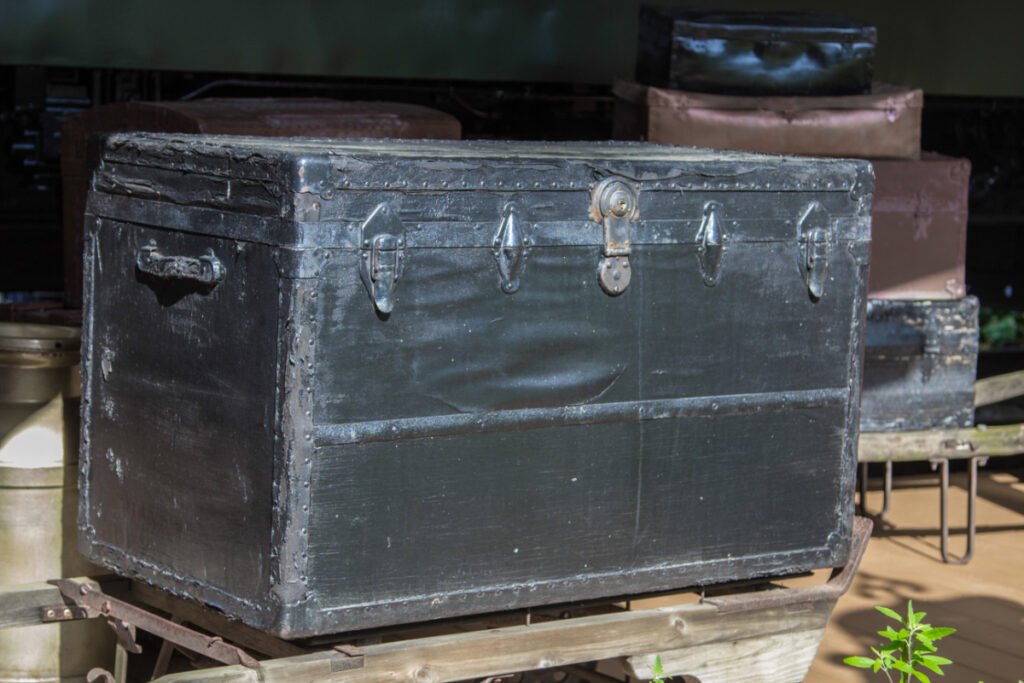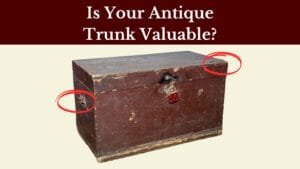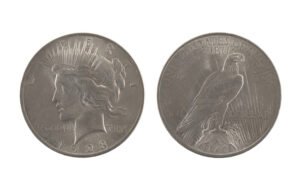If you love French interiors, you may long for an old trunk in your space. But what if I told you that you can be rich with it, too? Well, antique trunks, mainly the branded 1870s ones, are precious and desirable! And that makes them a great asset for decor and investment.
But how do you identify vintage trunks and decide their value? Worry not! Today, I’ll tell you all the trunk types and features for antique trunk identification and its price estimation. So, let’s get into it!
Key Takeaways
- You can spot antique trunks by their cuboidal shapes, bevel tops, seasoned tops, and carvings.
- Large, old trunks, about 18 – 20 inches tall, with 2-3 drawers are highly valuable. Remember to check if they have any chips, cracks, or faded portions to get the right price!
- Pick wood, zinc, or leather trunks for a high value! You can even use dark brown, maroon, or bare metal panels to reduce the cost.
- Portable steamers and flat-topped trunks are costly, while Saratoga or Jenny Lind trunks are cheaper! To value trunks correctly, look for alterations or branding.
Key Identification Features of Vintage Trunks

Vintage trunks look like any other storage chests. But since people used them for travel, they were lighter and minimal. And not to forget their striped canvas bodies and iron or oak frames!
But do you know which features make your old trunks more authentic?
- Zinc, Leather, or Metal coverings with Brown, Silver, or Orange lacquer
- Leather straps with metal latches or solid locks
- Stamped logos with additional brand and price tags at the base
- A slatted, cuboidal shape with 2-3 horizontal stiles on its face
- Flat and seasoned exterior with tapered beveling at the top
- Scalloped details with extra nail heads and a distressed polish
History & Evolution of Trunks
Did you know that the Victorians designed the first trunks to ease their sea travel? Tall and leather-covered, these 1870s trunks were solid and simplistic. You can also see an animal skin lining that makes them waterproof!
Then came the typical wooden crate trunks of the 1890s. These trunks were cuboidal and had a flat top for easy stacking. You can also find some leather, canvas, or tin designs with these. These trunks are more aesthetic and valuable!
Lastly, the later 20th Century trunks are more functional. So, you can find drawers, hangers, and wheels in them. And there may also be some locks and straps with their branded designs. So, they are very precious today!
7 Types of Antique Trunks With Values
Back then, people classified trunks into 6 types based on their tops and designs. But these types make antique trunk identification and valuation easier. So, let’s find out more about them!
1. Flat-Topped Trunks

You all must know a typical cuboidal chest with handles and drawers. Well, flat-topped trunks look the same but have handles and stiles on their faces.
You can also find leather straps, anchors, and clinch nailing with this one. And since these are old, big, and sturdy, they have a valuation of $3000 – 4000.
2. Dome-Topped Trunks

Dome-topped trunks are ornate and come in camel, humpback, or round shapes. You’ll get them in convex and concave lids with carved tops. But, they are more costly, pricing around $4000 – 5000.
3. Jenny Lind Trunks

Jenny Lind trunks are just like a bread loaf – bulging tops and curved centers. They usually have large brass bands and blind nailing on their edges. Plus, concealed latches and handles are also common with these.
But Jenny Lind’s trunks might buckle and turn blackish with age, giving it a low cost of up to $600.
4. Slatted Trunks

You can identify slatted trunks with their unique slit design and grooved joints. These are mostly cuboidal, but limited-edition trunks can also be square or round. So, they are aesthetic, and you can value them for $2000 – 3000.
5. Steamer Trunk

Steamer trunks were meant for travel. So, they are the most compact, lightweight, and flexible of all. You can also expect regional motifs, lining, and customized hangers on them. So, they are quite precious, valued at $15,000 – 20,000.
6. Saratoga Trunks
Saratoga trunks are elite holiday trunks with canvas and fabric lining. Branded by Stanley and Clinton, these cost around $500 – 600, depending on the size.
7. Antique Military Trunks
As you all might guess, military trunks are small, portable trunks, costing $600 – 3000 for army papers and weapons. So, they had water-resistant metal walls, insulation, and compartments for secret stuff. Also, each had a unique combination lock with wood cases.
7 Factors to Identify & Value a Vintage Trunk Correctly
Old vintage trunks are generally worth $50 to $200, with rarer, bare wood trunks with hand-polished finishes fetching up to $1,000 – $5,000 or even more. Naturally, the final value of a vintage trunk depends on age, brand, materials, size, and a few other factors.
1. Manufacturing Date & Age

It’s no secret that old trunks are precious! And it’s not just about the handmade finish and thick walls! But, the 1870s trunks used large, slatted logs that now hike the value of old metal trunks by 30 – 35%.
However, trunks from the later 1920s were small and commercial. So, steel and plastic replaced wood, and its value and intricacy declined!
Want more help dating your old trunk? Check out the hints below!
How Do You Identify Old Trunks from the 1870s?
You can spot these trunks by their solid wood panels and faded finishes. Most will be portable, weighing 24 lbs and 10-12 inches in height. Plus, you can find regional carvings, bevel tops, and natural motifs, valuing $40,000 – 50,000.
How Do You Spot Trunks from the 1890s?
Look for a 3-slat design and brown leather finish to identify these! You’ll also find a superior monogram or oil finish, costing up to $20,000.
How Do You Find Old Trunks from the 1900s?
Trunks from the 1900s are more aesthetic. So, you can find rich leather and brass finishes with them. They are longer, about 21 inches in height, and have extra cushions that cost $14,000 – 15,000.
How Do You Spot Trunks from the 1920s?
These trunks are small, about 40 inches long and 10 inches in height. They are more polished and have logos and patent numbers for easy tracking. But, they have low demand and a value of up to $1000.
Here are some patent numbers for your reference:
| Year | Trunk Age | Patent Number | Manufacturer | Valuation |
| 1925 | 97 years | US1561486A | Joseph A. Riordan | $17,000 |
| 1909 | 113 years | US957704A | Murphy Trunks | $25,000 |
Pick handmade tongue and grooved or screwed trunks for an old make.
2. Trunk Shape

The fancier the form, the lesser the value! So, it’s the old, cuboidal trunks that earn the highest value! You can also get antique trunks in curved or elongated shapes. But, those might have a machine construction, reducing the cost by 10 -12%.
Read on to know the average cost of each trunk shape!
| Shape of the Trunk | Average Valuation |
| Flat or Cuboidal | $800 – 1000 |
| Stacked or Wardrobe-like Trunks | $500 – 550 |
| Square or Cubical with a Curved Top | $300 – 400 |
| Round or Chest shaped | $350 – 400 |
| Stepped Trunks with Multiple Drawers | $200 – 250 |
| Camelback Trunks | $100 – 120 |
| Suitcase Trunk | $50 – 60 |
3. Color & Finish

An antique trunk’s color can tell a lot about its value! For instance, old, bare wood or metal trunks indicate an old and precious hand finish. Similarly, black, brown or exclusive colors like maroon and golden show an oxidized finish and hike returns.
But, if your trunk has bold orange or blue walls, it might be new and painted. So, you better avoid it if you want returns.
| Color of the Trunk | Average Valuation |
| Bare Metal or Wood | $1000 – 1200 |
| Dark brown, Walnut or Espresso | $700 – 800 |
| Maroon, Emerald Green or Golden | $900 – 1000 |
| Black or Cream | $500 – 550 |
| White or Orange | $300 – 400 |
| Blue, Teal or Aqua Colors | $80 – 100 |
Avoid buying veneer trunks as these are common and cheaper.
4. Materials
Antique trunks usually consist of four materials: hide, wood, fabrics, and metal. The hide ones are rare, customized, and handmade, so they are the most precious! In contrast, wood or leather ones might be machine-processed or painted, so they are cheaper.
And if you see a shiny patina on your trunk’s surface, it’s definitely steel! But such trunks dent and rust easily. So, you won’t get a high value for them.
| Trunk Material | Year | Average Valuation |
| Animal Hide, Skin or Hair | 1870 | $14,000 – 20,000 |
| Wood or Zinc (for Jenny Lind Trunks) | 1890 | $3500 – 4000 |
| Leather | 1900 | $3000 – 4000 |
| Crystallized Metal | 1920 | $2000 – 3500 |
| Canvas | 1920 | $1000 – 1500 |
| Embossed Metal | 1930 | $700 – 800 |
Crystallized metal trunks might look like aged quartz. So dust the trunk and flash a torch to check its sheen.
5. Antique Trunk Brands
Branded things are always costly, right? And vintage trunks are no exception! In fact, signed trunks from the 1900s cost $40,000 – 50,000 globally.
But how do you know if a trunk is branded? Well, for that, you need to observe some brand-specific hinges, locks, and bevels. Or, look for a logo or time and date patent on their stiles and brackets. This will help you sort the brands!
Want to know more? Check out these popular branded trunks for reference!
| Trunk Name | Manufacturer | Average Valuation |
| France Wardrobe Steamer Trunk | Louis Vuitton | $25,000 – 32,000 |
| Checkerboard Cabin Trunk | Moynat | $5000 – 12,000 |
| Tweed Leather Steamer Trunk | Oshkosh | $5000 – 6000 |
| American Steamer Chest Trunk | Taylor | $2000 – 2500 |
| Turntable Trunks | Hartmann | $4000 – 5000 |
6. Size & Space

The larger the size, the more precious the trunk!
Antique trunks are around 11-12 inches in height. But you can even get rare, customized pieces over 18 inches tall. You can even find some extra features like drawers, hangers, and brackets with them. So, naturally, they are more functional and valuable at $2000 – 3000.
7. Trunk Alterations
Believe it or not! However, any amateur alterations or restoration can devalue your trunk by 30-40%. Antique collectors pick original maker’s marks and handmade finishes for better value.
So, any DIY-painted or decoupaged trunks will be relatively cheaper. In contrast, trunks with faded colors and seasoned wood panels might value up to $2000.
How Do You Clean an Old Canvas Trunk?
Gently vacuum the trunk with a wide-angled hose and dust it carefully. Now, use a dry brush and clean out all the nooks and corners of the canvas sheet. You can also dab it with a sponge to remove nasty stains and cobwebs.
Where Can I Sell My Antique Trunks?
You can sell your antique trunks on e-commerce platforms like eBay, Etsy, and Brettuns Village. Or, you can visit your local antique shops and auctions and put your item for a bid.
Antique trunks are the showstopper of any vintage decor with their unique shapes and finishes. Large, handmade, and organic-colored trunks get the best deal. But even old trunks with a leather, animal skin, or zinc finish are precious!
However, people often confuse a larger trunk for a dresser and a smaller one for a safe! So, learn more about the different types of antique dressers and old safes to sort out this confusion!
Note: This article is intended for informational, educational, and entertainment purposes only. Some images are illustrative and may not represent actual brands, products, or related entities. All trademarks, product names, brand logos, packaging, and other intellectual property referenced remain the exclusive property of their respective owners. Any brand mentions or references are provided solely for descriptive and educational context and do not imply any formal or commercial association.










